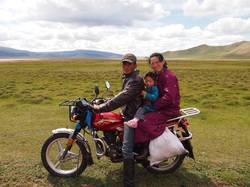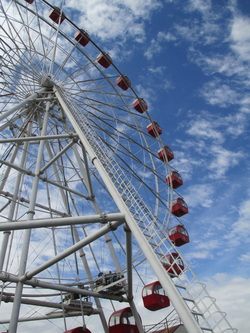Sometimes in life, reality teeters into unreality. Most of the Gobi desert is just vague, unfertile scrub land but we finally arrive at vast heaps of sand. They look like a long line of whipped cream separating green grass from blue sky. The beige waves cresting over the Mongolian steppes looks almost totally fake. In this age of green screens and photo shop it was difficult to believe we were really, actually present in front of such an iconic scene. On camels, no less.
Once we get climbing however, reality bites back. David Evan, a typical teenage boy, tests his mettle by taking the hard way, scrambling and scrabbling straight up the mountain of windswept sand. The rest of us try to find a gentler route but zig zagging is really the only alternative and not a whole lot better. About half way up I decide I’ve climbed enough sand dunes in my life time and sit down to enjoy the view. Vincent and the girls keep heading up after David Evan who has completely disappeared.

After a bit, envisioning sandvalances, we yell and call to him but the dips and valleys of the soft peaks smother our voices and we hear no response. Swearing profusely, Vincent struggles upward till finally we hear a yell and see a tiny green speck racing down the hill towards us. He made it to the top and is on his way back. Thank god, now we can all leave. The girls and I whoop and holler as we run down the sand, first because it’s fun, then faster, because our feet are burning up. We had left our sandals, at the bottom, so far away, too far to make it in one go. By the end I am carrying one girl ten feet, dropping her in a huddle and returning for the other, repeat ad infinitum. Vincent, also barefoot, is too far behind to help but we finally make it to the shoes. And the camels.
Why the camels, those “ships of the desert”, couldn’t have carried us over the dunes is an unexplained mystery. I have no idea what the Mongolian herders think of western tourists flirting with heart attacks and sun stroke stumbling around on their mammoth sand dunes but they have clearly decided that is not worth risking their animals. So the deal is, the camels bring you to the hills and take you back but right when the going gets tough, you are on your own.
This of course is the famous Bactrian, two humped camel, the one that looks like a Dr. Seus concoction rather than the sleeker and much more common, one humped Dromedary camel. If you had a pillow to put behind your back (which we did not) they would be as comfortable as an armchair. These softer, smaller beasts were far less intimidating than their taller, crankier Indian cousins. They were definitely much fuzzier and furrier than any camel we rode in India and seemed positively sweet as opposed to always vaguely annoyed. They are so comfy in fact, I could envision months and months of travel transporting my valuable spices along the ancient silk road. On the other hand, a 4 wheel drive is pretty comfy too so it’s a transportation toss up (not).

One of the many astonishing things about this corner of the world is the sheer scale of the countryside. On no day did we drive less than 6 hours to get from place to place with very little in between. This was, remember, taking it easy, purposely stretching out what would normally be a one day trip into two. Mongolians think nothing of driving 18 hours at a clip. And what are they driving on? Outside of the three or four big cities there are no roads in Mongolia, just tire tracks scratched across the steppes.

Our driver does not like following another car and on the rare occasions we meet up with another car he inevitably speeds up to pass, at one time barely avoiding a massive ditch hidden by the bus he was trying to overtake. Generally speaking, however, there are so few cars this is, fortunately, not really an issue.

GPS is the bane of Tuya’s existence since tourists keep google mapping where they want to go and can’t understand that the drivers know there are no Straight Lines in Mongolia. Often they have to drive miles out of the way to go around hills or avoid ravines. The ground itself is both rocky and muddy so the slightest rainfall slows even 4WD jeeps to a crawl.

Whenever two vehicles meet, both drivers immediately confer over road conditions. This was particularly important for us since the rains had just begun and they could wreck havoc.”How is back where you came from?” “very deep mud, stay to the east, it is less washed out” or “pretty good but don’t try and ford the river, it is already too high”, etc. Of course, new tracks detouring around obstacles would criss cross with the old tracks and even seasoned drivers were constantly faced with figuring out new routes. You could think you were taking a detour around a herd of camels and end up driving up to someone's winter Ger
So a lot of the discussions were frankly asking where we were and how to get to where we were going. On both driver’s sides. A couple of days into our trek, Tuya pulled out a very detailed geographic map with lots little squiggly lines. When I asked what they were she said, "those are roads". Roads? Permanent roads? No, she explained, they were just suggestions of where roads used to be or were likely to be, more like clues to a road map than an actual functioning road map. Lest you think I am exaggerating - this photo is not an example of off roading, this was an actual road. A road so well used and so ordinary it was one of the larger lines on the map!
In Mongolia it is considered it very bad luck to ask “how long till we get there?” You get there when you get there. This did not matter so much to us. We had plenty of time and carrying our own food and tents we were not that much different from the nomads and herders bedding down where ever they found themselves at night. But I can’t imagine the tourist industry getting much more developed if tour agents cannot guarantee their clients that they will be delivered to some sort of rest spot and/or meal at the end of each day.



























 RSS Feed
RSS Feed